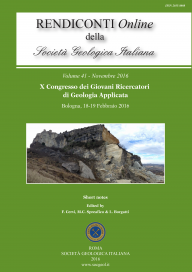
Preliminary characterization of slope stability in a small basin in the South-West of Sardinia (Italy)
Sonia Cristina Aldana Martinez (a), Stefania Da Pelo (a), Maria Teresa Melis (a) & Salvatore Vacca (a)
(a) Department of Chemical and Geological Sciences, University of Cagliari, Via Trentino, 51, 09127, Cagliari, Italy. E-mail: so.aldanamartinez1@studenti.unica.it .com
Volume: 41/2016
Pages: 108-111
Abstract
The assessment of slope instability in small drainage basins is relevant because their impacts affecting population and infrastructure are usually very fast and sometimes destructive. This study presents the methodological approach to assess the stability of a small granitic river basin located in the South-West of Sardinia (Italy). In the drainage area two different kinds of slope deposits, originated at different times, were analysed. In order to determine the origin and evolution of the different deposits, the bodies of the moved masses and the head scarps were respectively characterized through profiles, grain size analysis and geomechanic classification. The profiles were surveyed using Jacob staff or Abney level. The survey tape method was applied to determine the grain size distribution (GSD) in cross sections at each slope deposit. The GSD was analysed using standard statistics. The geomechanical characterization of the cliffs in the headscarps above the deposits were made using Bieniawski (1979) and Romana (1985) methods. The former deposits have a regular longitudinal profile. The plan form can be convex or slightly concave. They are formed by cobbles and boulders and they are matrix free. They were classified as "debris slope" (DS).The cliff above the DS was evaluated vulnerable to plane failure and completely unstable. The new deposit hillslope gradient and transversal sections are irregular. It is formed by cobbles, boulders and pebbles, it has matrix of granules sand and silt. It is a complex mass movement between rock fall and rock avalanche (RF-RA).The cliff above the RF-RA is vulnerable to plane failure and toppling and is partially stable.
Keywords
Get Full Text